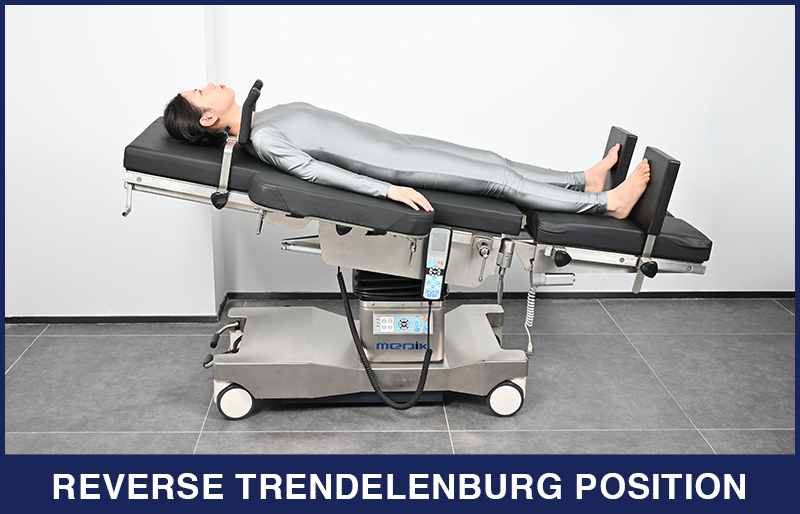

Introduction
Proper patient positioning in surgery is critical to both procedural success and patient safety. Among the various positions used in the operating room, the Reverse Trendelenburg Position (RTP) has become increasingly important, especially in laparoscopic and upper abdominal surgeries. This article explores the clinical applications, physiological implications, advantages, and considerations of using the Reverse Trendelenburg position in surgical practice.
What is the Reverse Trendelenburg Position?
The Reverse Trendelenburg position involves tilting the patient’s body so that the head is elevated above the feet, typically at an angle of 10° to 30°. This is the opposite of the traditional Trendelenburg position, where the body is tilted with the feet above the head. The patient lies supine on the surgical table, and the entire table is inclined.

Surgical Applications of the Reverse Trendelenburg Position
The Reverse Trendelenburg position is commonly used in various surgical procedures, particularly those involving the upper abdomen, thoracic cavity, and head and neck. These include:
- Laparoscopic cholecystectomy
- Gastroesophageal reflux surgery (Nissen fundoplication)
- Bariatric surgery
- Esophageal and gastric cancer surgeries
- Thyroidectomy and parathyroidectomy
- Neurosurgical procedures involving the posterior fossa
In these cases, the position aids in organ retraction, gravity-assisted exposure, and reduces the risk of aspiration.
Physiological Effects
The RTP affects multiple physiological systems, which must be considered during anesthesia and surgery:
1. Cardiovascular System:
- Decreased venous return to the heart may result in lower preload and cardiac output.
- Patients with hypovolemia or cardiac compromise require careful monitoring.
2. Respiratory System:
- Improved diaphragmatic excursion and lung expansion, especially in obese patients.
- Decreased risk of pulmonary aspiration, making it safer during induction and emergence from anesthesia.
3. Intracranial and Intraocular Pressure:
- RTP can reduce intracranial pressure (ICP) and intraocular pressure (IOP), making it suitable for selected neurosurgical and ophthalmic procedures.
Advantages of the Reverse Trendelenburg Position
- Enhanced surgical exposure: Gravity pulls abdominal contents downward, improving the view for upper abdominal procedures.
- Reduced intra-abdominal pressure: In laparoscopic procedures, lower insufflation pressures may be needed.
- Lower aspiration risk: Critical in patients with full stomachs or reflux.
- Better oxygenation: Beneficial in obese and pulmonary-compromised patients.
Challenges and Risk Management
Despite its advantages, RTP is not without risks:
- Hypotension: Due to reduced venous return, especially in hypovolemic or anesthetized patients.
- Sliding risk: Patients may slide downward on the table. Proper padding and secure strapping are essential.
- Positioning injuries: Care must be taken to avoid nerve compression, particularly in prolonged surgeries.
Solutions:
- Use of anti-slip pads, shoulder braces, and safety straps.
- Continuous hemodynamic monitoring and fluid management during anesthesia.
Tips for Safe and Effective Use
1. Use high-quality operating tables that allow precise angulation and stable support.
2. Coordinate with the anesthesia team to optimize cardiovascular stability.
3. Ensure that positioning devices like pads, restraints, and gel supports are available and correctly used.
4. Implement a surgical positioning checklist as part of your OR safety protocol.
Conclusion
The Reverse Trendelenburg position is a vital tool in modern surgery, offering distinct benefits in terms of exposure, ventilation, and patient safety. Understanding the physiological implications and implementing best practices can optimize outcomes and reduce complications. For surgical teams, mastering this position enhances both efficiency and patient care.
References
1. Le Blanc-Louvry, I., et al. (2000). Laparoscopic cholecystectomy: Influence of Trendelenburg and reverse Trendelenburg positions on respiratory mechanics. Surgical Endoscopy, 14(5), 372–376. https://doi.org/10.1007/s004640000046
2. Caplan, R. A., et al. (1990). Adverse outcomes of anesthesia management of patients in the Trendelenburg and Reverse Trendelenburg positions. Anesthesiology, 73(1), 41–46.
3. Talab, H. F., et al. (2009). Effect of head-up tilt position on oxygenation during laparoscopic surgery in obese patients. Anesthesia & Analgesia, 109(5), 1530–1535.
4. Knight, D. J., Mahajan, R. P. (2004). Patient positioning in anaesthesia. Continuing Education in Anaesthesia Critical Care & Pain, 4(5), 160–163.